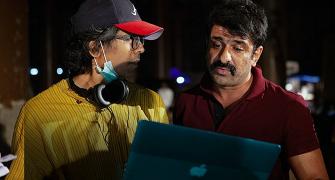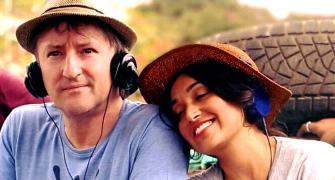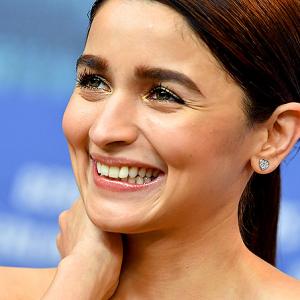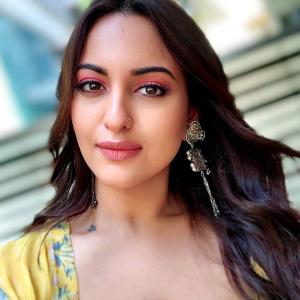Jaane Bhi Do Yaaro, Parinda, 1942: A Love Story, Devdas, Kareeb, Mission Kashmir, Munnabhai MBBS, Rang De Basanti, Delhi 6, Bhag Milkha Bhag, Kalank... all bear the visual stamp of Binod Pradhan's genius.
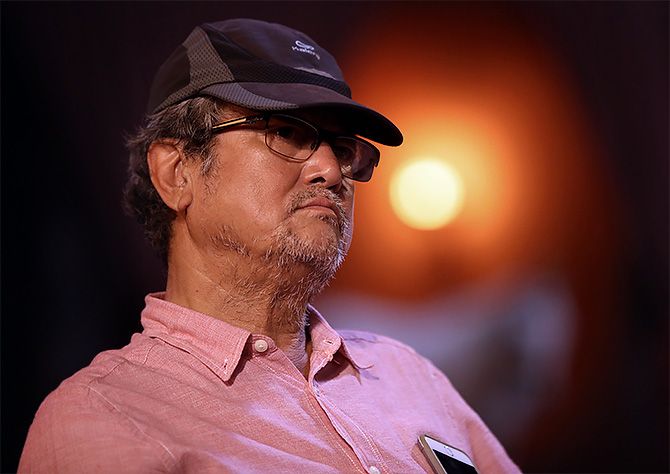
One of Bollywood's most iconic lovemaking scenes is one where the lovers are barely seen.
Moments before they are gunned down in Parinda, Anil Kapoor and Madhuri Dixit feature in an erotic scene, which is heightened because the sex is more imagined than actually seen.
The lighting is very differently done for a film made in 1989, something new even for its then young director Vinod Vidhu Chopra.
And a lot of the credit goes to its cinematographer Binod Pradhan.
"We didn't show their expressions and I think that was better because when people are making love, what sort of expressions will they have? It might look sleazy," Pradhan tells Ronjita Kulkarni/Rediff.com.
The scene was lit up only by backlight, with a strong rimlight showing the entangled bodies.
"People thought something was wrong with the projection! They couldn't see anything!" Pradhan says, with a laugh. "They probably wanted to see more than what was shown."
Parinda is one of the many films in Binod Pradhan's long career that has made him a contemporary cinematic legend.

Binod Pradhan did not want a career in cinematography.
His father worked in a photo studio in Kalimpong, West Bengal, where they lived, before starting his own studio.
Seeing the magic of prints coming out in the dark room fascinated young Binod, and he wanted to take up photography.
"But I wanted to do more than what my father was doing -- catering to the public in the small town of Kalimpong. It's a nice place, but it wasn't meant for what I wanted to do," he says.
So he signed up for a course at the Film and Television Institute of India in Pune. The three-year course started with a year in photography and then specialised in cinematography.
That's how fate made Binod Pradhan a cinematographer.
After graduating from FTII, starting a career in Bombay was no child's play.
"I had every intention of going back to Kalimpong because I was a very timid sort of person. Where do I start searching for work in a city like Bombay?" he recalls.
Plus, Bombay gave him a culture shock.
"You must understand where I am coming from. Kalimpong was like a village then. Almost everyone knew everyone there. To come here, with no friends... I used to take a train from Goregaon (north west Mumbai) to Churchgate (south Mumbai), sit at Marine Drive and just look at the sea. That's all I did," he remembers of his first year in the city.
"I was dreadfully lonely that year."
"I could never go and ask for work. I am not a very social guy. I am not aggressive in terms of getting work," he says.
Luckily for him, a cameraman named Prem Sagar asked Pradhan to assist him.
After that, he started assisting Barun Mukherjee.
But he did not want to be stuck as an assistant, and one fine day, he quit.
He had no work for almost a year.
He returned to Kalimpong and told his father that he could not make it in Bombay.
He started working in small documentaries as well as Assamese movies for acclaimed director Jahnu Barua.
But his father always encouraged him and asked him to work in at least *one* film in Bombay.
So Pradhan, who was married by this time, decided to try his luck again and went back.
And then he got Jaane Bhi Do Yaaron.

"I don't know what Vinod (Chopra) saw in me (during Jaane Bhi Do Yaaro ) but we did many films together," Pradhan says.
"All the films made then (in the 1980s) had almost the same look. They were being lit in the same way. I was very influenced by Hollywood, as well as what (Satyajit Ray's cinematographer) Subrata Mitra was doing in his black and white films," he adds.
After doing the murder mystery Khamosh together, Binod and Vinod had long discussions on how they would do Parinda differently.
So when Binod spoke about shadows, Vinod backed him.
"In those days, everything was flatly lit with nothing to hide. I looked at the way the shots looked, naturally lit," he says. "I was influenced by The Godfather also."
Parinda told the tale of two brothers, played by Anil Kapoor and Jackie Shroff, set against the underworld.
The film's dark story lent itself to dark lighting.
But their next film together, 1942: A Love Story, looked very "pretty".
"Parinda was about the underworld. 1942 was more about two innocent people trapped in the British Raj. It was basically a love story," he explains.
Binod and Vinod worked on Kareeb, Mission Kashmir and Raju Hirani's Munnabhai MBBS.

The game changed when Pradhan was signed up for Sanjay Leela Bhansali's Devdas in 2002.
"It was my biggest film. I was not used to such huge sets," Pradhan says, shaking his head.
"Also, I am not a fast worker. To achieve something, I take a lot of time. I don't know any other way. I can't just place two lights and take a quick shot; I could never do that."
"No one really cribs about me taking time, except this one actress, who had once told me that I would never succeed in Bombay films. When I asked why, she said because I was too slow. I think she was getting upset. But I can't do it any other way."
The large sets of Devdas included three houses -- Devdas's house, Paro's house and Chandramukhi's house.
While the entire film looked superbly lit and grand, Pradhan is proudest of his work in Paro's house, which had beautiful stained glass windows.
"Lighting coloured glass is not easy at night," he explains. "You can see the colours when there is bright light outside. But we were shooting night scenes, so there were no colours. So I put white mosquito nets behind the stained glass and lit it up. That's how the colours from the stained glass could be seen. It sounds easy now, but it wasn't then," he says.
The lake set, outside Chandramukhi's house, was also tough, he says. They needed 40 generators for it!
"Almost all the generators of the Bombay film industry were used for those sets. When other DOPs wanted generators, they were told, woh sab le gaya Devdas ke liye," he says with a laugh.
The next problem was, of course, where to park the 40 generator vans.
"Sanjay (Leela Bhansali) had to take more space from the studio. Nitin (Desai, art director) had to level the space so that the generators could stand there. That was a logistical nightmare," he recalls.

One of his favourite portions is the More Piya song, picturised on Shah Rukh Khan and Aishwarya Rai.
The song, set in a forest, sees a lot of glitter on the trees and leaves.
"I am very happy about that little idea I had!" he exclaims. "Small things sometimes work wonders and it tickles me. Nitin Desai didn't even mind because it is quite a task putting glitter on so many leaves. But Sanjay does not believe in compromising."
"In fact, even when there was a crisis and he got stressed out, he would come and tell me the problem. It could be some financial problem, but Sanjay would always say, 'Don't compromise on anything'," he adds.
Devdas is the longest film he has done in his career.
"We worked around 270 days, working nights mostly," he says. "We started looking like vampires by the end of it -- all white!"
Nanhe Jaisalmer, he says, was his shortest film at about 30 days.

Pradhan looks back at Rakyesh Omprakash Mehra's Rang De Basanti, which started a movement when it released.
Starring Aamir Khan, Siddharth, Sharman Joshi, Atul Kulkarni, R Madhavan and Soha Ali Khan, the film compared the present day to freedom fighter Bhagat Singh's times, and the story would alternate between the two eras.
"The modern boys were carefree, so we used a wider lens and included people in a frame," Pradhan explains. "If someone is talking, we didn't want to take only him, we took others in the background as well. But when we showed the past, we used closer shots with less movements."
"Since I had a photo studio background, I would see a lot of old pictures. I used to paint black and white pictures and make them colour. So I told the colorist to give a yellowish look -- not sepia -- and the faces should look painted. We took a lot of time to do this."

In his 43-year career, Binod Pradhan has worked in a slew of films like Raju Ban Gaya Gentlemen, Delhi 6, 2 States, Bhaag Milkha Bhaag, Baaghi and his latest, Kalank
Karan Johar's magnum opus production, starring Madhuri Dixit, Sanjay Dutt, Alia Bhatt, Varun Dhawan, Sonakshi Sinha and Aditya Roy Kapur, may not have sent the cash registers ringing, but it looked undeniably grand.
Set in the 1940s, the film had some exquisite scenes and sets.
Red seems to be a recurring colour in its frames.
"Abhi (Abhishek Varman, director) says red signifies passion, love, hate, violence... It is a very strong colour. That's why it has been used again and again; we used it in the climax too."
The film is so grand that certain scenes, which required elaborate lighting, feature only for a second or two.
Does he feel bad when scenes he has worked so hard on get snipped at the editing table?
"While doing Mausam, Pankaj Kapur had told me, while editing, that a certain scene would no longer be in the film. He said it in a very matter-of-fact way, and he thought I would feel bad. But I said, fair enough. It requires a little bit of maturity. In almost every film, there will be something that you will shoot and really like, but which will not be included," he says.

'We had timed the shot because they cannot stay inside the water for too long. They can't be gasping for breath when they come out. So they had to be dipped underwater and then taken out, and we had to take the shot.'
'There's no conscious effort in making it larger than life. The entire film *is* larger than life in the way it's done,' Binod Pradhan says.
Binod Pradhan has done quite a few films with Madhuri Dixit. How has their rapport been?
"We are friendly, but I am very busy on the sets. The actor may be chatting or not even present, but for a DOP, I have to prepare for the shot. After the shot, I have to prepare for the next one. So I hardly get time to chat."
To add to that, Binod Pradhan says he is hardly a talker.
"The amount I am talking to you now is the maximum I talk," he says and bursts out laughing.
The smile vanishes, and Binod admits, "I am a loner. I have one or two friends that I meet often outside my work. Right now, in fact, I can think of only one. I don't have a best friend as such. Maybe I was too busy pursuing my career, so there aren't too many friends."
"I wish I had some."

Which actor's face does the camera love?
"Jackie Shroff has very nice features," he says. "And I like the wrinkles on Naseer's (Naseeruddin Shah) forehead."
"You cannot go wrong with Aishwarya and Madhuri. They have delicate expressions. I find Alia very pretty. Also, Shraddha Kapoor."
Has he ever rubbed off agelines on screen? Or whitened darker actors? Or even made faces slimmer?
Pradhan laughs heartily and dodges perfectly: "More than ageless, we have to work on pimples, scars and blemishes."
Actors tend to have a favoured profile. Do they try to push that forward?
"You should know the angles the actors prefer. They have studied their faces and experimented with it, and they know the best angles. So you must complement that. Some want to look to the left, some like to look right," he says.
How does he remember them all?
"Chaar-paanch log toh hote hai," he says with a laugh.
"If both of them want the same profile, it won't work. They have to look at each other. Whoever is important for that moment wins. The boys let the girls have the better angle. There were some old actors who wanted a certain angle and certain kind of lighting only. And I have seen that old actors, when they look in other angles, not their good angles, look really bad. So it's good when they choose their profiles."

With Kalank done and dusted, Binod has a couple of days to himself before he moves on to his next film, Rumi Jaffrey's Chehre.
"If I don't switch off, I will go mad!" he exclaims, as he stretches out on his brown sofa, in his 17th floor duplex in Andheri, north west Mumbai.
The windows open out to beautiful fields of greenery, a rare sight in Mumbai.
His dogs -- a Spitz named Rani and a crossbreed named Tommy -- laze on the carpet, and don't bark during the entire duration of the interview.
Shades of earthy browns in his living room change to pink in one corner of the room. This corner belongs to Pradhan's granddaughter Naaya, all of two-and-a-half years old.
Piles of games, tiny pink chairs and toys take up the space, even as her name hangs proudly from the window.
His granddaughter, along with his elder son and daughter-in-law, live in Worli, south central Mumbai, and visit every weekend. His younger son lives with him.
So how does he spend his time between projects?
"I do my homework," he says. "I am always looking at films and technology on my laptop. I also do research for my granddaughter, what food she should eat, what toys she should get... She is finiky about eating, so I do some homework about that."
Does he cook?
"No. But when I do, everyone starts panicking!" he laughs.
Binod Pradhan's soft laugh stays in my ears long after the interview ends. He may have been in the world of glamour for decades, but the genius cinematographer remains one of the most grounded film folk in the industry.


